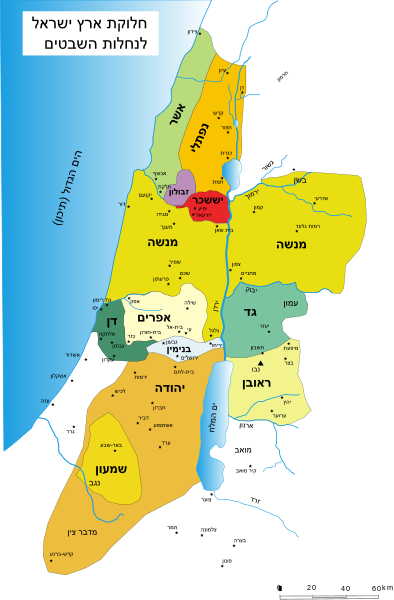The Time of the Ivrim
Note this map of Israel, as it was divided into the territories for the various shevatim:

The Tribes of Israel
There are two things odd about the south-west corner of the map. First, the Gaza Strip is not included, and second, the tribe of Shim’on lives in an island within Yehudah’s land.
These two are connected. Shim’on never succeeded in conquering its promised portion of Israel, and therefore settled within an empty part of the Judean desert.
This may be related to the story of Pinechas. The generation leaving the Sinai Desert encounter the people of Midian. The Midianim, realizing that the Jews were getting supernatural help, despair of attacking the Jews directly. Instead, they first try to employ Bil’am to curse us, and when that fails, they insert a wedge between the Israelites and our G-d by promoting assimilation. They set up an idol of Baal Pe’or, a god of personal license, and the women of Midian went out to the Jewish camp and offered sex. Things got to the point where Zimri ben Salu, the head of one of Shim’on’s clans, went to bed with Kozbi vas Tzur, a Midianite princess. At that point Pinechas had to stop the downward trend and killed Zimri and Kozbi.
But we see that Shim’on entered Israel while still struggling with “ol malkhus Shamayim — the yoke of the Kingdom of Heaven”. And this might explain their lack of success.
(This is likely also the basis of a Yiddishism. A luckless person who appears to be creating his own lack of success is a “shlemiel“. This is probably a reference to the nasi of Shim’on named in the beginning of Bamidbar, Shelumiel ben Tzurishadai. Shim’on being thought of as the luckless bumbler among the shevatim.)
However, the tribe of Shim’on was not alone. On this map, we see Dan just to the north of the Gaza strip up just until the area currently called “the Dan” — the environs of Tel Aviv. However, that’s not where they end up settling either!
We learn in Yehoshua pereq 19 that they instead headed north, and that is the land of Dan in biblical Hebrew. “From the Dan to Beer Sheva” is an idiom for the inhabited areas of Israel — Shofetim 20:1; Shemuel I 3:20, II 3:10; 17:11; 24:2, 15;
Shimshon haShofeit came from Dan (Shofetim 13:2) and is even called Bedan (Shemuel I 22:11, the identification of the two is in Rosh haShanah 25a). He leads the Jews who are living in the land of the Pelishtim (Shofetim 13:5) from Ashqelon (14:19) down through Azza.
The interesting part is the Shimshon’s downfall has related causes to those of the tribe of Shim’on. He intermarries when he weds Delilah, perhaps accidentally (not knowing her conversion was false, see Rambam Issurei Bi’ah 13:16), but still he lived with the influence of someone who didn’t buy into ol malkhus Shamayim. Sexuality also plays a role, as his first wife has an affair with one of the groomsmen shortly at the end of the wedding week (14:20) , and he too finds a zonah when he gets to the city of Azzah (16:1). The gemara (Sotah 9b) traces a pattern from this, to his love of Delilah, to his downfall.
Avraham is called an Ivri (Bereishis 14:13), literally referring to his descent from Eiver (R’ Nechemiah, Medrash Rabba 42:8) and/or his coming to Israel by “crossing” the Jordan (Rabbanan, ibid). Rabbi Yehudah (ibid) explains the connotation as his willingness even when the whole world is standing on the wrong side, to stand across from them on the side of Truth. We similarly find Yoseif called an Ivri when he resists the seduction of Potiphar’s wife (40:15). Ramban ad loc comments that Ivri is a term used for the Jewish People when we stand distinct.
The Jewish midwives in Egypt are the “meyaldos haIvrios” when they refuse Par’oh’s orders as are the women who refuse to give up their children (Shemos 1:15) — and the midwive’s resistance is attributed to their Yir’as Hashem (v. 17)
But the only time we as a people are called the Ivrim is…. in contrast to the Pelishtim, the people of Azza! “וַיֹּֽאמְרוּ֙ שָׂרֵ֣י פְלִשְׁתִּ֔ים מָ֖ה הָֽעִבְרִ֣ים הָאֵ֑לֶּה — And the leaders of the Pelishtim said, “Who are these Ivrim? …” (Shemuel I 29:3) A stark contrast to the assimilationism of Shim’on and Shimshon / BeDan, who failed to conquer and hold on to the area.
In short, the southern coastline of Israel has always been a problem. It isn’t current events; Hamasistan has deep metaphysical roots.
And from what it appears, the healing of this problem requires a transition in which, as Rabbi Yehudah put it, “כל העולם כולו מעבר אחד, והוא מעבר אחד — the whole world is on one side, and he” — Abraham and the Jewish People — “is on one side.”



Actually, I believe that the root for “schlemiel” is from a contraction of the hebrew “SheLo Mo’il”; ineffective, unhelpful…
Random House, Online Etymology Dictionary, American Heritage all attribute it to the nasi of Shim’on. See https://dictionary.reference.com/browse/schlemiel
But they only bring it as a possible source, not definitive.
Should I write to Philologos, or do you want to?